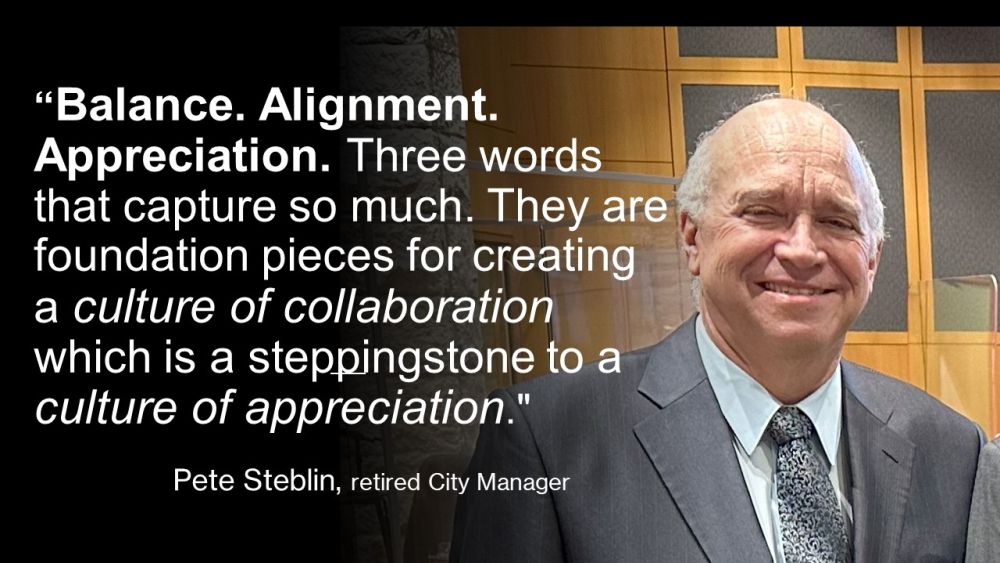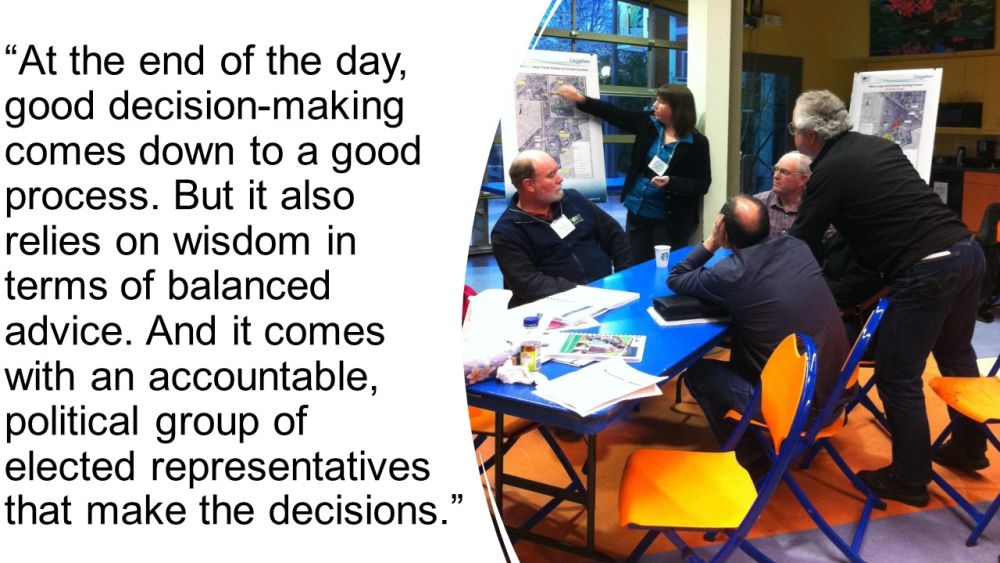REFLECTIONS ON CREATING A CULTURE OF APPRECIATION IN THE CITY OF COQUITLAM: “Balance. Alignment. Appreciation. Three words that capture so much. They are foundation pieces for creating a culture of collaboration which is a steppingstone to a culture of appreciation,” stated Pete Steblin, former City Engineer and City Manager
Note to Reader:
Published by the Partnership for Water Sustainability in British Columbia, Waterbucket eNews celebrates the leadership of individuals and organizations who are guided by the Living Water Smart vision. The edition published on March 12, 2024 features a conversational interview with Pete Steblin, former City Manager with the City of Coquitlam in the Metro Vancouver region. In the interview, he reflected on his experience in building trust through collaborating to create a culture and cycle of appreciation in the city.

Collaboration – steppingstone to a culture of appreciation
Peter Steblin is an engineer who progressed to City Manager. His local government career began with the City of Vancouver and concluded at the City of Coquitlam in 2023.
When he joined Coquitlam in January 2008, controversy surrounded the way the city had mandated use of green infrastructure in new development. One of his first priorities was to stickhandle a path forward to a balanced solution.
Balance is key to good government
“At the end of the day, good decision-making comes down to a good process. But it also relies on wisdom in terms of balanced advice. The essence of my guiding philosophy as a City Manager is distilled into the three Ts which are trust, time and think,” states Pete Steblin.
Trust: “When there is a significant level of trust in technical recommendations, Councils rarely override them. Staff explains recommendations. The Council makes the decisions. Trust is fragile and can easily be broken. When trust is lost, decades of good work can be lost.”
Time: “If everything is a priority, nothing is a priority! We took the ‘reality of time’ into consideration when we set workload priorities in Coquitlam. We ranked them as A, B or C because this allowed us to manage timelines effectively. It helped Council focus on what is most important to make progress over time.”
Think: “We are not perfect. We struggle with challenges related to blindly following standards of practice. Too often, that can lead to unsuitable or unsustainable solutions. So, I encouraged staff to think about compromises and maximizing the benefit for the money spent.”

EDITOR’S PERSPECTIVE / CONTEXT FOR BUSY READER
“With adoption by the Regional Board and ministerial approval of the Metro Vancouver region’s first Liquid Waste Management Plan in 2002, local governments formally embraced the concept of watershed-based community planning. Other than Surrey, however, none had yet developed a solid mechanism for rolling out watershed-based approaches and processes,”stated Kim Stephens, Waterbucket eNews Editor and Partnership Executive Director.
“In Coquitlam, 2003 was a defining year. The Council amended the city’s Official Community Plan. The new policies required that Watershed Plans be developed first and Neighbourhood Plans second; and that land use plans account for watershed conditions and needs.”
“In 2003, the City was clearly visionary when it first embraced and then formalized a watershed-based approach as a foundation piece in the Official Community Plan. By the latter part of the decade, however, Coquitlam was viewed by others in the region as the example of what not do. This is the backdrop for the story behind the story that follows.”
Coquitlam is the model for keeping things simple, practical, and implementable
“At the time, the City’s approach to watershed-based community planning, rainwater management and green infrastructure was quite idealistic. It was also prescriptive and impractical. As a result, the city could not implement what was proposed. That is the crisis situation that I inherited at the end of 2007,” recalls Pete Steblin.
Through a trust-building process guided by Pete Steblin, the City of Coquitlam turned a crisis into a transformational outcome. The city emerged as a regional green infrastructure leader. “The final solution has to be doable; it has to be achievable,” emphasizes Pete Steblin.
“If the City of Surrey is the gold standard for a watershed-based approach to rainwater management and green infrastructure, then the City of Coquitlam is the silver standard,” concludes Kim Stephens. “A noteworthy aspect of the Coquitlam story is how quickly municipal staff learned from experience, adapted their approach, and successfully instilled a new way of doing business.”

STORY BEHIND THE STORY: Collaborate and create a culture of appreciation – extracts from a conversation with Peter Steblin
The “story behind the story” that follows weaves quotable quotes by Pete Steblin into a succinct storyline. This preview about his experience in leading and managing change is extracted from an interview included in a legacy resource that the Partnership will release later in 2024.
“Coquitlam has arrived at a good place, but the journey was not easy. In fact, we had to work our way through some pretty contentious periods, notably from mid-2007 through early 2009. We persevered, we adapted, and we progressed,” reflects Peter Steblin.
“In 2004, Coquitlam had adopted a prescriptive manual for low impact development. The manual was too theoretical and unbuildable. This resulted in significant complaints from the development community which, in turn, culminated in Council-Staff conflict.”

|
Balance idealism with pragmatism to achieve beneficial outcomes for the community

“So, what we did in 2008 and 2009 was to re-think things and say something is better than nothing. So much depends on what your political support is, where society is at, and what are the trade-offs. When we made those changes to on-site rainwater management requirements, they were good changes, and they were well received.”
Net environmental benefit is a concept that works:
“In 2009, the Council endorsed a ‘systems approach’ philosophy which aims to offset impacts in one area of a watershed with gains in another area for a ‘net environmental benefit’. Figure out what is the best thing for society to do and where you would get the most bang for the buck.”
“On-site rainwater management was not an issue after we made those changes in 2009. The process was working. The solution was there. When things are working, and you are the City Manager and it does not come across your desk, then it is not an issue.”

Reflections on creating a culture of appreciation in the City of Coquitlam
“Over my career, I have worked in four cities, and observed many cities across the country. There are angry communities and there are appreciative communities, and I have worked in both.”
“This experience provides me with context for concluding that something really good is going on in Coquitlam. It is an appreciative community and generally elects collaborative individuals to Council because the community is looking for positive things to do.”

“Balance. Alignment. Appreciation. Three words that capture so much. They are foundation pieces for creating a culture of collaboration which is a steppingstone to a culture of appreciation.”
“This applies to the relationship between the political and administrative wings. It also applies to the organization as a whole.”
“An airplane analogy is one way to describe the relationship. Think of one wing as political and the other as administration. If either wing is not functioning properly, the plane will crash.”

“Balance. Alignment. Appreciation. Three words that capture so much. They are foundation pieces for creating a culture of collaboration which is a steppingstone to a culture of appreciation.”
“This applies to the relationship between the political and administrative wings. It also applies to the organization as a whole.”
“An airplane analogy is one way to describe the relationship. Think of one wing as political and the other as administration. If either wing is not functioning properly, the plane will crash.”

“Instill a culture of continuous improvement and giving back to the community so that the community elects good, well-meaning people. It is a cycle.”
“The community elects good people to council. And councillors rely on staff to come up with ideas. The council supports those ideas and is willing to fund them. Staff carries them out. The community notices those ideas being implemented, and they are happy. It is a cycle! “
“The community becomes even more appreciative. If you keep that cycle going, there is no end to it. The cycle actually does work!” concludes Pete Steblin.

Living Water Smart in British Columbia Series
To download a copy of the foregoing resource as a PDF document for your records and/or sharing, click on Living Water Smart in British Columbia: Collaboration – steppingstone to a culture of appreciation.
DOWNLOAD A COPY: https://waterbucket.ca/wcp/wp-content/uploads/sites/6/2024/03/PWSBC_Living-Water-Smart_Peter-Steblin_2024.pdf


